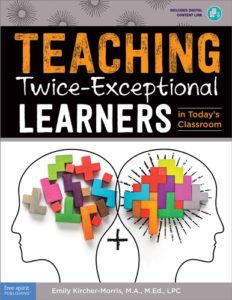Supporting Twice Exceptional Learners
Teaching Twice-Exceptional Learners in Today’s Classroom
By Emily Kircher-Morris
(Free Spirit Publishing, 2021 – Learn more)
Reviewed by Sarah E. Pennington

Since these students are often misunderstood or perceived as simply lazy by teachers, I was excited to dive into Teaching Twice-Exceptional Learners in Today’s Classroom to see what insights and practical tips Emily Kircher-Morris has to offer. I was not disappointed!
Two core sections

The second section includes information about interventions for 2E students with exceptionalities, including specific learning disabilities, ADHD, Autism, anxiety, processing difficulties, and depression.
Discussion of each of these exceptionalities includes the common signs/symptoms of each, how it is identified, how it affects students in the classroom, and specific tools and ideas that teachers can utilize to support 2E students with this concurrent diagnosis.
Also included are vignettes about students who are 2E with the specific exceptionality being discussed, as well as a chart for teachers to help them identify appropriate accommodations for each exceptionality. These charts, in particular, are powerful and simple tools for teachers.
And there’s more
The text also includes reproducible pages for use by teachers, as well as activities that can be used with students to support them in building skills such as self-advocacy (asking for help) and understanding empathy. These pages are also available as digital downloads for those who have purchased the book.
My favorite tool is the very first one in the book, a checklist to help teachers recognize 2E students in their classroom. This tool provides teachers with guidance for considering the strengths and needs of students in an effort to identify those who may need to be referred for additional screening.
Overall, this is a reader-friendly text that has lots of tools teachers can utilize easily and purposefully. It clears up misconceptions teachers may have about 2E students and provides teachers with the tools to serve the needs of these students academically and socio-emotionally.
Sarah E. Pennington taught middle school language arts for a decade before returning to school to pursue her doctoral degree in curriculum and instruction. She is currently an assistant professor at Montana State University, where she teaches pre-service educators the ins and outs of supporting young literacy learners. She also provides professional development in literacy and motivation to teachers across the nation. You can visit her online at sarahepennington.com.




































